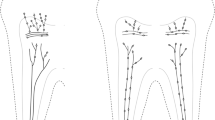Summary
We developed a method that allows us to label nociceptive neurons innervating tooth-pulp in rat trigeminal ganglion neurons using a retrograde fluorescence-tracing method, to record ATP-activated current in freshly isolated fluorescence-labeled neurons and to conduct single cell immunohistochemical staining for P2X1 and P2X3 subunits in the same neuron. Three types of ATP-activated current in these neurons (F, I and S) were recorded. The cells exhibiting the type F current mainly showed positive staining for P2X3, but negative staining for P2X1. The results provide direct and convincing evidence at the level of single native nociceptive neurons for correlation of the characteristics of ATP-activated currents with their composition of P2X1 and P2X3 subunits and cell size. The results also suggest that the P2X3, but not P2X1, is the main subunit that mediates the fast ATP-activated current in nociceptive neurons.
Similar content being viewed by others
References
Surprenant A, North RA. Signaling at purinergic P2X receptors. Annu Rev Physiol, 2009,71:333–359
Kaczmarek-Hajek K, Lorinczi E, Hausmann R, et al. Molecular and functional properties of P2X receptors-recent progress and persisting challenges. Purinergic Signal, 2012,8(3):375–417
Chen CC, Akopian AN, Sivilotti L, et al. A P2X purinoceptor expressed by a subset of sensory neurons. Nature, 1995,377(6548):428–431
Lewis C, Neidhart S, Holy C, et al. Coexpression of P2X2 and P2X3 receptor subunits can account for ATP-gated currents in sensory neurons. Nature, 1995,377(6548): 432–435
North RA. P2X3 receptors and peripheral pain mechanisms. J Physiol, 2004,554(Pt2):301–308
Scadding JW, Koltzenburg M. Neuropathic pain. In: McMahon SB, Koltzenburg M, eds. Textbook of Pain, 5th ed. Churchill-Livingstone, Edinburgh, 2005,973–999
Cook SP, Vulchanova L, Hargreaves KM, et al. Distinct ATP receptors on pain-sensing and stretch-sensing neurons. Nature, 1997,387(6632):505–508
Luo J, Yin GF, Gu YZ, et al. Characterization of three types of ATP-activated current in relation to P2X subunits in rat trigeminal ganglion neurons. Brain Res, 2006, 1115(1):9–15
Liu YW, Luo JL, Ren H, et al. Inhibition of NMDA-gated ion channels by bis(7)-tacrine: whole-cell and single-channel studies. Neuropharmacology, 2008,54(7): 1086–1094
Collo G, North RA, Kawashima E, et al. Cloning of P2X5 and P2X6 receptors and the distribution and properties of an extended family of ATP-gated ion channels. J Neurosci, 1996,16(8):2495–2507
Vulchanova L, Riedl MS, Shuster SJ, et al. Immunohistochemical study of the P2X2 and P2X3 receptor subunits in rat and monkey sensory neurons and their central terminals. Neuropharmacology, 1997,36(9):1229–1242
Kobayashi K, Fukuoka T, Yamanaka H, et al. Differential expression patterns of mRNAs for P2X receptor subunits in neurochemically characterized dorsal root ganglion neurons in the rat. J Comp Neurol, 2005,481(4):377–390
Xiang Z, Bo X, Burnstock G. Localization of ATP-gated P2X receptor immunoreactivity in rat sensory and sympathetic ganglia. Neurosci Lett, 1998,256(2):105–108
Khakh BS, Humphrey PP, Surprenant A. Electrophysiological properties of P2X-purinoceptors in rat superior cervical, nodose and guinea-pig coeliac neurones. J Physiol, 1995,484(Pt2):385–395
Li C, Peoples RW, Weight FF. Cu2+ potently enhances ATP-activated current in rat nodose ganglion neurons. Neurosci Lett, 1996,219(1):45–48
Li C, Peoples RW, Lanthorn TH, et al. Distinct ATP-activated currents in different types of neurons dissociated from rat dorsal root ganglion. Neurosci Lett, 1999,263(1):57–60
Grubb BD, Evans RJ. Characterization of cultured dorsal root ganglion neuron P2X receptors. Eur J Neurosci, 1999,11(1):149–154
Ueno S, Tsuda M, Iwanaga T, et al. Cell type-specific ATP-activated responses in rat dorsal root ganglion neurons. Br J Pharmacol, 1999,126(2):429–436
Burgard EC, Niforatos W, van Biesen T, et al. P2X receptor-mediated ionic currents in dorsal root ganglion neurons. J Neurophysiol, 1999,82(3):1590–1598
Petruska JC, Cooper BY, Johnson RD, et al. Distribution patterns of different P2X receptor phenotypes in acutely dissociated dorsal root ganglion neurons of adult rats. Exp Brain Res, 2000,134(1):126–132
Author information
Authors and Affiliations
Corresponding author
Additional information
These authors contributed equally to this work.
This project was supported by grants from the National Natural Science Foundation of China (No. 30970927), the Natural Science Foundation of Hubei Province, China (No. 2008CDA053) and the Wuhan Science and Technology Foundation (Nos. 200970634270, 201250499145-27).
Rights and permissions
About this article
Cite this article
Liu, Yw., Chen, Xq., Tian, X. et al. P2X3, but not P2X1, receptors mediate ATP-activated current in neurons innervating tooth-pulp. J. Huazhong Univ. Sci. Technol. [Med. Sci.] 33, 423–426 (2013). https://doi.org/10.1007/s11596-013-1135-6
Received:
Published:
Issue Date:
DOI: https://doi.org/10.1007/s11596-013-1135-6




